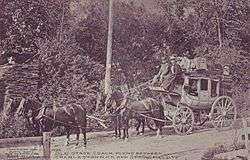Concord stagecoach
(Seeley Stable Museum,
Old Town San Diego, California)
.jpg)
Concord stagecoaches are horse-drawn stagecoaches which employ a style of suspension and construction particularly suited to North America's early 19th century roads. Leather thoroughbraces suspend passengers who are in constant motion while the stagecoach is moving. The swaying is accepted by passengers for the shock absorbing action of the leather straps and for the way the special motion eases the stagecoach over very rough patches of roadway. The coaches were first developed and built by coachbuilder J Stephen Abbott and wheelwright Lewis Downing of Concord, New Hampshire. The expense of the high quality of the vehicle's construction had to be set against its structure's good lasting qualities improved by the relative smoothness of its thoroughbrace suspension system. These features attracted passengers.
Abbott and Downing's Concord design replaced European designs which had short useful lives under punishing North American conditions. They were exported to Australia and South Africa.
Railroads replaced stagecoaches in the middle of the 19th century, but Concord coaches remained in commercial use into the 20th century and continue to be used in parades and for publicity purposes by Wells Fargo Bank.
Dimensions
The smallest six-passenger Concord weighed two and a quarter tons or 2.25 metric tonnes and stood six feet eight inches or two metres tall.[1]
Design features
Construction

Brake levers on the outside edge either side
Timber: white oak, ash and basswood braced with iron bands.[1] Iron fittings. Leather and canvas.
Undercarriage
The undercarriage supports the leather thoroughbraces[note 1] carrying the body. The two axles are tied together by a firm undercarriage braced by three straight perches (lengthwise frame members) and given a relatively slim transom (the transverse members at either end of the perches).
Each end of each transom holds an upright metal standard from which hang the leather thoroughbraces.[2]
Brakes
The back wheels have brake blocks acting on the iron tires. The driver controls them with a foot lever to his right at the side of his footboard.[2]
Body
The body needs to make no contribution to the rigidity of the undercarriage and so is more lightly constructed than was the custom for European vehicles. This lightness also eases progress on the very rough roads.[2]
There are three bench seats accommodating up to nine people though models to seat six and twelve passengers were available. The benches at the front and back of the body have limited headroom.[2] Passengers on the center bench are given no backrest but steady themselves with a broad leather harness suspended across the coach by straps from the roof.[1]
Another six passengers can travel in the open air on the body's roof. There is an external luggage compartment or boot at the back of the body and another boot for valuables below the driver's seat at the front.[2]
Windows are glazed, but in the 19th century the glass did not withstand hard overland mail trails of the western United States.
Photo gallery
A Concord Coach in Hadley Farm Museum, Massachusetts
Horses
The leading horses are known as the lead horses. The wheel horses or wheelers are the back pair nearest the coach's wheels.[2] The number of horses, usually four or six, could be even more. Two horses alone would very soon tire.
Operation

It is not possible to guide a Concord coach with European-style precision. The Concord body continuously shifts. The driver or coachman has to sit slightly askew and brace himself with the aid of a steeply angled footboard. He cannot keep his reins in a steady contact with the horses' mouths. He has to bend his arms and elbows to constantly compensate, and his body always leans slightly forward. He holds his left reins in his left hand and his right reins — separated by his middle finger — in his right hand and not all in one hand like a European could. It is easy to slacken an individual rein but much more difficult to shorten it. His right hand also has to control his whip used on the wheel horses. If obliged to make his right hand free, then he must lay all the right hand reins in his left hand unseparated.[2]
The horses were harnessed very loosely by European standards because without proper roads the horses had to be allowed to avoid their particular obstacles. The Concord pole, though mounted to allow far more play, moved less.[2]
The result was the coach's direction was straighter than with a European coach, it did not respond to every irregularity in the road.[2]
.jpg)
(Seeley Stable Museum)
Abbot-Downing stage wagon
Concord stagecoaches were expensive. Abbot-Downing also supplied a much simpler, lighter, and less expensive vehicle which they named Overland wagon and later Western passenger wagon.[3]
These are the vehicles which opened up the stage routes of the U.S. West.[3]
Notes
- ↑ Strong leather straps supporting the body of a coach or other vehicle; also "thorough braces"
References
- 1 2 3 Melody Groves, ‘’Butterfield’s Byway’’, The History Press, Charleston SC 29403, 2014 ISBN 9781625850379
- 1 2 3 4 5 6 7 8 9 Robert Sallman. "Coaching in the New and Old World", The Carriage Journal: Vol 16 No 4 Spring 1979. edited by Thomas Ryder. Carriage Association of America 1979
- 1 2 Ken Wheeling, They Called Them Mudders. The Carriage Journal, Vol 43 No 5 October 2005